Six for Life Blueprint Program®

Financial Success with the tools right in your pocket.
We provide you with mobile friendly client portal to help you take back control of your financial destiny. See your complete financial picture from your smart phone or tablet. Anytime. Anywhere.
Hit the pause button, create the space, and take a time out for you!
The Six for Life Blueprint Program® is specifically designed for the individual or couple who are seeking coaching, education, and personal advice to their specific circumstances.
The program is designed to be completed with six to eight meetings over a twelve-week period.
The Six For Life Blueprint Program®‘s purpose is to increase your level of awareness so you can ask better questions, make better decisions, thus giving you greater control over your financial future.
The Six For Life Blueprint Program® will help you:
– Forecast and track your expenses allowing you to keep more of your
money.
– Review your current and long-term debt with the goal of reducing or
eliminating the need for credit financing.
– Maximize the value you are receiving from your insurance while seeking
to reduce your overall cost.
– Increase your savings and investments, diversify your risk, while
seeking to improve your returns.
– Review your taxable income while seeking strategies to reduce your federal
and state income taxes.
– Create an effective estate plan before it is too late.
A Blog for your Life and Money
Cash Flow Management

Tinstaafl Theory
Tinstaafl Theory. Don’t you just love the word free? It’s certainly a word that is often used in marketing phrases like: Buy one, get one free Free trial Free download Free shipping Free sample Free estimate Free gift with purchase Free demonstration Free consultation Another simple but powerful word is save. Have you ever had the experience when you are in the checkout lane at your local grocery store and after they have zapped your credit card for a couple of hundred bucks while handing you the receipt, you are informed of how much money you have saved? Really? After a quick search, I discovered a few more familiar marketing phrases that basically lead the consumer to believe they can save you money: “reduce spending on…..” “Lower the payments on…..” “Get discounts on…..” “Cut the costs of…..” “Lesson the…..” “reduce debt…..” “Trim the fat from…..” “find the best prices for…..” And if the free offer or being able to save you money won’t do the trick, then how about a few of these humdingers? No obligation Special offer Limited supply Offer expires Call right now Cancel anytime Pay nothing Before they’re gone Award-winning Money back guarantee No minimum Offer ends soon Not sold in stores Same day delivery Lowest price Guaranteed overnight delivery Act now Call anytime Same day service Based on the marketing messages, the only way it appears possible to save any money today is by acting now on that special offer for the limited supply before they’re gone. Remember, the offer ends soon and with all of the savings, we can continue to spend less and save more. Really? When I was a teenager back in the seventies and without sounding too cynical, my family had one telephone called a land line that hung on the wall, a T.V. antenna, and one 25” console T.V. that sat on the floor with three to four channels, depending on the reception. That was it! And we didn’t spend a whole lot of time or money on it, either. But today with the average cable package with internet at $165 per month and cell phones at $100 per month, the total monthly cost to watch T.V., surf the internet, and talk or text is $265 per month. This doesn’t include the amount of time and energy we spend watching these devices so they can continue to compete with pop-up ads and slick commercials that tell us what to eat, what to drink, and how to lose weight as well as pitching the benefits of prescription drugs. Really? So what if you saved $265 per month from the age of thirty-five to the age of sixty-five and earned a net after-tax rate of return of 6%? You would have over $266,000! Oh well, you only live once. I love my country, and am very grateful to have been born in the U.S.A, but when it comes to money in America, I believe in the Tinstaafl Theory. There Is No Such Thing As A Free Lunch!
Credit Debt Management

Credit Lines & Credit Bureaus
Credit Lines & Credit Bureaus. I am simply amazed by the number of credit card offers and new solicitations that I receive each month. Checks are attached and ready for me to add the payee along with my signature. A lot has been written about personal debt in America and the consequences that come along with it. While impossible to create debt without first being offered credit, the easy availability of credit is the stimulus that feeds the addiction of over spending. Many of us think of addiction in terms of substance abuse while never considering other possible forms of addiction. A synonym of the word addiction is dependence. How many of us today have become dependent on our credit lines to facilitate our emotional decisions when it comes to our purchases? I would be remiss if I didn’t speak to the ability to shop online with the use of our smart phones. Are there any limits to what can or cannot be purchased today online? And if that isn’t enough temptation, there are two cable channels that are devoted to sharing the daily gospel of shopping. In addition to credit lines, another industry has risen that is convincing Americans of the need to monitoring their credit report – credit bureaus. The three primary credit bureau companies are: Equifax – equifax.com P.O. Box 740241, Atlanta, GA 30374-0241. Ph. 1-800-685-1111 Experian – experian.com P.O. Box 2104, Allen, TX 75013-0949. Ph. 1-888-397-3742 TransUnion – transunion.com P.O. Box 1000. Chester, PA 19022. Ph. 1-800-916-8800 If you visit any of the three credit bureau websites, they are busy pitching FICO scores and the need for you to shell out $240 a year to monitor your credit reporting and scores. While you can go ahead and sign up for the twenty bucks a month based on some marketing narrative, I am not sure how that is going to help you improve your FICO score. The most effective way to improve your credit score is for you to understand how the system works and to work the system to your advantage. The people with the highest credit scores are those who have always paid as agreed, kept their existing credit balances low in relation to the credit line limits, and in general do not have any real need for credit because they have cash. I am not suggesting that you ignore your credit score and who is reporting it. Personally, I annually pull my three credit bureau reports and review the reported information for accuracy, and I can do that for a lot less than $240 bucks. One of the best places for you to begin to educate yourself on this subject is to go to the Federal Trade Commission’s website under Credit and Loans: https://www.consumer.ftc.gov/topics/credit-and-loans. This is a great resource that can be trusted because the Federal Trade Commission is responsible for the enforcement of the Fair Credit Reporting Act, a federal statute to protect you, the consumer, from those who may be gaming the system.
Risk Management

The Aging Process
While the aging process is a subject that most of us would certainly rather shy away from, it is a subject that will affect the majority of us. As you are likely already aware, life expectancy has increased substantially over the last century. However according to the CDC, the leading cause of death and disability in the United States is due to chronic diseases. As defined by the U.S. National Center for Health Statistics, a chronic disease lasts for three months or longer. Common types of chronic diseases and conditions are listed, below: ALS (Lou Gehrig’s disease) Alzheimer’s disease and/or dementias Arthritis Asthma Cancer Chronic obstructive pulmonary disease (COPD) Cystic fibrosis Diabetes Heart disease (example – congestive heart failure) Obesity Osteoporosis My work with the public for the last twenty-seven years in the areas of life and money has allowed me to experience firsthand the challenges many of us will face as we age. While chronic illnesses are emotionally difficult to endure for individuals, families and friends, it can also be very financially difficult due to the emotional uncertainty about the financial resources required to provide quality care for our loved ones. If a person becomes afflicted with a chronic illness at age sixty-five or older, the Department of Health and Human Services, Centers for Medicare & Medicaid Services, and Chronic Care Management Services are very specific in what services will be covered and/or reimbursed. The challenge facing the United States today is the aging of the baby boomers (born between 1946 and 1964). By some estimates, the boomer population is over 75 million. As this population continues to age, the increased medical demands will create a significant burden on the government entitlement programs, namely Medicare and Medicaid. Just for clarity, Medicare is the federal health insurance program for people who are age sixty-five and older or those under the age of sixty-five who have been declared disabled by the courts. In contrast, Medicaid is a jointly funded, Federal-State health insurance program for low-income and needy people, e.g. welfare. To qualify for Medicaid, an individual’s financial resources will be assessed. For services related to chronic illnesses, any private expenses are first paid by the individual with any remaining expenses possibly covered by Medicaid. This being the case, anyone with substantial financial resources will be required to cover the expenses of chronic illnesses until they fall below certain threshold levels established by specific State Medicaid requirements. For those individuals who believe they may be able to game the system by hiding or transferring assets prior to applying for Medicaid benefits, they may want to think twice as the states have adopted a look-back period. For example, the look-back period in the state of Indiana was extended to five years. Moving forward over the next twenty years, the current health care system that covers the issue of chronic illness is, by all measures, unsustainable. Due to budget constraints, the states will be forced to implement new protective measures to prevent those with financial resources from gaming the system. For anyone who has created sufficient amounts of investment capital and/or real assets, it would be wise to educate themselves on the cost of healthcare in order to be better positioned for the final stages of life.
Asset Management

Understanding Investment Risk
Understanding Investment Risk Hands down, the fourth quarter of 2008 and the first quarter of 2009 were trying times for those of us who were invested in the capital markets. While we tried to constrain our range of emotions, I remember thinking and sharing with my clients that the only silver lining was the severity of the situation. This meant that the United States Congress, the U.S. Treasury Department, and the U.S. Federal Reserve would have to act decisively in order to avoid a global economic catastrophe. On October 3, 2008, President George W. Bush signed into law the Troubled Asset Relief Program (TARP). While it appears that the worst is behind us, the memories of the experience will be with us for years to come. When asked to define investment risk, most of my clients tend talk in terms of the irrevocable loss of principle. This definition would be plausible, provided they had invested into a specific security, such as the stock of their employer. Investment risk is divided into two primary categories, unsystematic risk (specific risk) and systematic risk (market risk). Unsystematic risk is diversifiable whereas systematic risk is not diversifiable. Most of us have heard the phrase “don’t put all of your eggs into one basket”. This is the simple definition of diversification. Unsystematic risk is risk that is specific to a company or an industry. Can you think of any industries or companies of the past that no longer exist today? What about Enron, Arthur Anderson, American Motors Corporation? What about products that once thrived but today are no longer relevant? Products like video the cassette recorder, Polaroid land camera (self-developing film), floppy disk, or telephone booth. Unsystematic risk is considered diversifiable. By choosing to increase the number of companies and industries that are invested in, the probability decreases that these industries and companies would all cease to exist at once. Systematic risk is any risk associated with the overall economic market and is further defined by the following: Purchasing Power Risk: Inflation Reinvestment Risk: Reinvest at a lower interest rate” Interest Rate Risk: U.S. Federal Reserve increasing or decreasing the Fed Funds Rate Market Risk: Government economic policy or geo political factors Exchange Rate Risk: Depreciation or appreciation of differing countries currency As stated earlier, systematic risk is associated with the overall economic markets and is not diversifiable. The challenge with systematic risk is the influence of macro-economic criteria such as gross domestic product (GDP), unemployment rates, oil prices, international trade policies, consumer spending, and many other areas of concern that lay beyond the direct control of any individual, company, or government. Think of it this way. What would happen if the west coast experienced a prolonged severe drought that adversely impacts the supply of the nation’s fruits and vegetables? How would this effect the cost? What happens when the production of the world’s supply of oil is reduced? Gas prices increase and require a larger percentage of your income, reducing the amount of money available for you to spend on other necessities. Everything that I have shared so far influences market volatility. When experiencing market volatility, many of us find it difficult to manage our emotions. In financial terms, volatility is measured by standard deviation, a term used to measure the dispersion around the mean. For example, what is the probability of the outcome if you were to place $5,000 in a guaranteed account earning a fixed interest rate of 4%, compounded annually for fives year? Five years later, your $5,000 investment would be worth $6,083. What are your chances of this occurring? If you answered 100%, you are correct! Does your answer change if instead you decide to take your chances and purchase a stock that your friend recommends? Five years later, how much money will you have? Not a clue? Without fully understanding the volatility of the investment, it would be impossible to understand the potential range of returns. While we all desire to maximize our investment returns, do we also not want to be compensated for the amount of risk taken? Why take unnecessary investment risk without being compensated for the risk? What is true for me, investments in the market is more about managing and mitigating risk then the desire of chasing returns. But then again, I, like everyone, have my own personal bias. Are you willing to put all of your money at risk?
Tax Management

The Basics of Tax Language
The Basics of Tax Language. This certainly isn’t a subject most us, including myself, like to think about and certainly isn’t one that appears to be going away anytime soon. As wealth accumulates for future needs, the tax rates by federal and state governments will likely increase due to budgetary issues. Therefore, my goal is to share some basic tax language, concepts, and distinctions that I believe every person should know. Let’s first begin with a list of terms: Earned income versus unearned income Tax deductions and exemptions versus tax credits Social Security versus Medicare tax Long and short-term capital gains tax Marginal tax rate versus effective tax rate Tax deferred versus tax-free For 2017, federal income tax has seven progressive brackets – 10%, 15%, 25%, 28%, 33%, 35%, and 39.6%. The amount of tax you owe depends on your income level and filing status. Earned income includes wages, salary, professional fees, and commissions. In contrast, unearned income is income derived from savings accounts, certificate of deposits, and investment accounts. Because the income classifications are taxed at different rates, it is important to understand the distinction between the two. With a progressive tax system, reducing your taxable income is important. This can be accomplished through tax deductions and exemptions. A tax deduction is a reduction in tax obligation that is accomplished by lowering the taxable income. Common tax deductions include charitable contributions, 401k contributions, mortgage interest, and student loan interest. In contrast, a tax credit is a monetary amount that directly reduces the actual taxes owed to the government. On earned income up to $127,200 in 2017, the Social Security tax rate is 6.2% for employees and 12.4% for the self-employed. In addition, the Medicare tax rate on earned income is 1.45% for employees and 2.9% for the self-employed. High-income earners also pay an additional 0.9% in Medicare taxes on earning above certain amounts. A capital gain is the profit that is realized when investments (like property, stocks, and bonds) are sold. A short-term capital gain is any investment owned for exactly one year or less. Whereas a long-term capital gain is any investment held for more than a year. How long the investment is held influences the tax treatment of the capital gain. Short-term capital gains are taxed at ordinary income tax rates while long-term capital gains are taxed at a lower rate. Because of our progressive tax system, a basic understanding between taxable income and the seven tax brackets is important. Specifically, the taxable income levels that shifts the tax rate from 10% to 15%, from 15% to 25%, etc. This higher tax bracket is referred to as the marginal tax rate and is the top rate that you are being taxed. In contrast, the effective tax rate is calculated by dividing your income taxes paid into your gross income. And lastly, a discussion about tax deferred versus tax-free Is warranted. Tax deferred refers to accounts that have favorable tax treatment. This allows income and capital gain taxes to be deferred and not paid until a future point in time. In contrast, tax-free refers to accounts that are free indefinitely from taxation of income and capital gains.
Estate Management

Why Estate Planning
Why Estate Planning. For most of us, we begin our lives with very little in the way of personal assets. The journey of life often begins with the vision of finding the right career, buying our first home, getting married, and having children as we enjoy the experiences that are shared by many. We walk through life with little awareness of the possible life shocks that happen and often dismiss the notion as this could ever happen to us. When confronted by the media, we witness devastating fires, automobile accidents, debilitating diseases, and horrific crimes. Often, these events cause the loss of life or permanent disability. We all hope and believe that we will be able to live an active life, complete with paying off our debt, accumulating sufficient assets, raising our children, becoming grandparents, and leaving life at a ripe old age while beloved by everyone. While our assumption of living out our lives without any major life shocks will hold true for most, we will invest the majority of our time and energy working to save and accumulate sufficient assets for the final chapter of our lives.Typically, this is done without any real awareness of how to protect and preserve those assets for those who we care about the most. Often we spend thousands of dollars each year paying on insurance to protect our homes, automobiles, life, and health in the event that something beyond our control occurs. But without proper planning at the end of our life, we may spend thousands of dollars on legal fees, taxes, healthcare, and estate shrinkage due to the forced sale of assets at the most inopportune time. In addition, the emotional cost to family relationships due to the lack of planning can divide families for many generations. Because of my personal and professional perspective, what is true for me is that there are potentially two costs. First, the emotional cost of losing a loved one. And second, the emotional loss that is often compounded due to family division over the estate settlement process. The second loss can often be mitigated had there been proactive and proper planning with open communication prior to the death of a loved one. When too late to rectify, I am greatly saddened to learn of families that historically shared some of life’s greatest experiences only to end with irreconcilable differences after the death of a loved one. Many times, the lack of planning was the cause for the great family divide. At some point in our lives, all of us will experience the loss of loved ones, and our memories will hold those loved ones close to our hearts. With proper estate planning, open communications, and a little proactive time and energy on planning, what can be a very difficult time may be a much less complicated transition. Being proactive will go a long way to help create the space needed for the mourning process.
